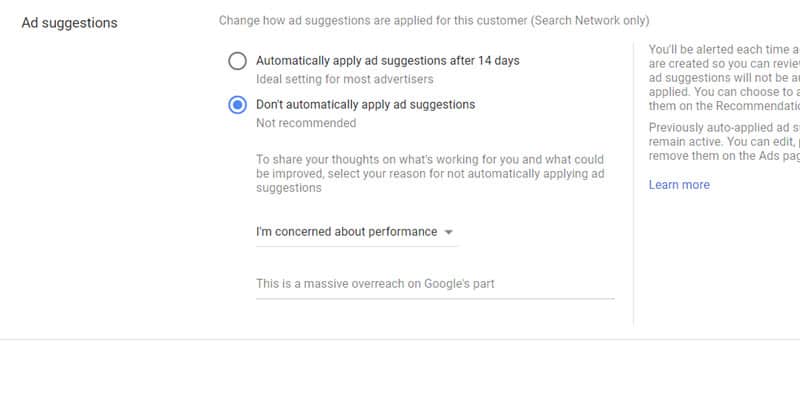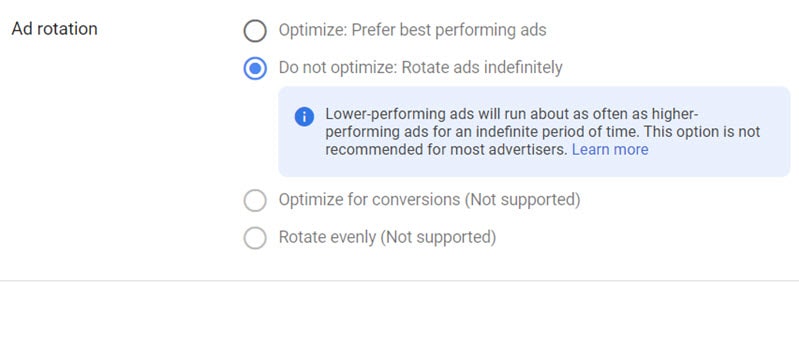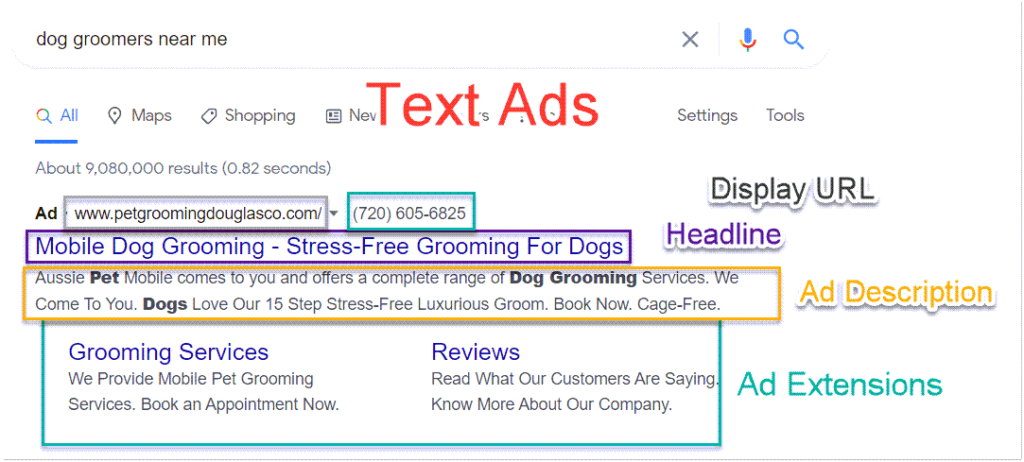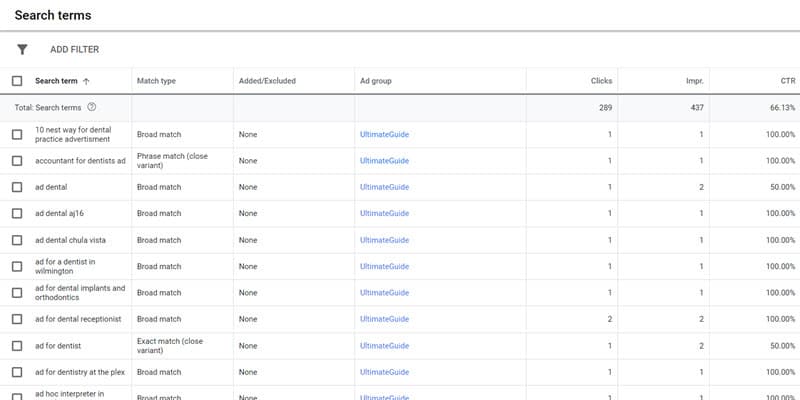PPC Audit Checklist for Google Ads
This checklist describes the process that we use when conducting an audit on your Google Ads or Microsoft advertising accounts. Feel free to use this PPC audit checklist as a resource for auditing your own ad account. We use this checklist as part of our PPC Consulting services. Also, be sure to check out our PPC Audit overview page.
PPC Audit Step 1: Historical Performance Baseline
We’ll look at your baseline historical performance for your ad campaigns. This analysis helps us to pinpoint any PPC performance problems. Doing this allows us to come up with a course of action based on changes that have occurred in the account. After we implement audit recommendations, this baseline also serves as a way for us to measure performance improvements.
PPC Audit Step 2: Ensure Link to Google Analytics
The next step in the audit is to verify that your Google Ads account is properly linked to your Google Analytics Account. Google has official documentation on connecting Analytics with Google ads here.
Goals in Google Analytics
We’ll also verify that you have goals set up in your Google Analytics account for desirable user actions. For lead generation accounts, we usually set up goals for both phone calls and for form leads that we can attribute to paid search. For more about setting up goals in Google Analytics – please refer to their official documentation.
When your Google Ads and Google Analytics are linked, and goals are properly established, we can see conversions within Google Ads that we can attribute to Campaigns, Ad Groups, Keywords, and even search terms. This allows greater insight into your customers. You’ll know exactly what search terms lead to a conversion.
PPC Audit Step 3: Conversion Tracking Implementation
The next item on the checklist is to verify that conversion tracking implemented correctly in order to measure your results accurately. Without it, there is no way to measure the actual effectiveness of your ad campaigns.
For most lead generation clients, you’ll be tracking phone calls and form leads. Google Ads provides a snippet of code that we can install on your site manually – or by using Google Tag Manager. This code allows you to easily track conversions from paid ad campaigns when a conversion action (such as completing a form) takes place.
PPC Audit Step 4: Review Budgets
Daily budget is the next item in the PPC audit. We look in your account and ensure your budget makes sense based on your overall goals.
Limited By Budget
If your campaigns are frequently limited by budget and you’re still achieving a positive ROI, we’ll look at potentially increasing the budget. If you’re constrained by budget and not meeting your goals, we’ll look to see if it makes sense to reduce budget – or to adjust other parts of the account.
Under Budget
Accounts that aren’t spending to budget may also represent a serious issue. Often times this is due to bids on keywords that are too low – or bidding on keywords with low search volume. We’ll perform a close analysis to make sure that the account is being properly optimized.
Google Ads Budget Scripts
Google has a daily budget option but will spend up to 2x of your daily budget whenever Google’s algorithms deem that it is necessary. As a result, you lose a bit of control over the management of your ad account.
We have developed a Google Ads Script that will prevent Google from committing a runaway daily ad spend. We will apply this script to your account to give you better control over Google’s ad spend.
You must have conversion tracking properly implemented in order to accurately measure your results. Without it, there is no way to measure the true effectiveness of your ad campaigns.
PPC Audit Step 5: Google Account Settings
We’ll audit ad account settings are appropriate for your goals. A problem that we commonly see in Google Ad accounts is that too many advertisers take Google’s advertising recommendations.
Google also in some cases implements its recommendations by default – even when it may not be in your best interests. Remember that Google is in business to generate revenue for Google, and many of its recommendations will be detrimental to your ad campaigns.
Here are two essential settings that we recommend most advertisers should ensure are appropriately set in their accounts.
Turn Google Ad Suggestions off
Choose “Don’t Automatically Apply Ad Suggestions”. Google has advertising-related algorithms and will write advertising copy for you based on your existing ads. We don’t recommend having a computer algorithm write your ads for you.

Select “Don’t automatically apply ad suggestions” to prevent Google from writing advertising copy on your behalf
Despite advances in machine learning, you don’t want to leave writing your advertising copy to a computer algorithm. You know your advertising objectives and goals. You know your customers much better than Google’s algorithms. You need to be involved in writing the ads.
Excluded Content
Choose all available options so that your advertising is much less likely to appear on websites or apps which can be offensive or unrelated to your brand.
Free PPC Guide
Download our Free Guide and Learn How to Get Quick Wins in Your Paid Search Campaigns Right Away!
Click Here for More Info
PPC Audit Step 6: Google Ads Campaign Settings
Networks
Search Network
An essential part of the audit is to ensure you have selected the proper networks. For most advertisers, you’ll want to make sure that you’re only advertising on the Search Network.
Google Search Partners
When you create a new campaign on the Google Search network, search partners are enabled by default. Google search partners consists of hundreds of sites external to Google as well as many Google related properties.
Some advertisers have success with Google Search partners. If you have extra budget, it may be worth experimenting with search partners after your Google Search Network campaigns are already optimized.
The problem with search partners is lack of control over your ad distribution. It is a bit of a black box as you don’t know exactly where your ads are appearing – so it requires quite a bit of faith that Google Ads is looking out for your best interests by advertising with Search Partners. Search partner sites are also not of the same quality as the Google search engine, so your results likely won’t be nearly as good.
Google Display Network
Local service providers should rarely participate on the Google Display Network – unless they have a strong branding strategy. Don’t ever combine a Display ad campaign with a Search Network campaign.

Network settings for your Google Ads Campaign
Locations
Another esential part of the ppc audit is to ensure that you’re only targeting people who are likely to become prospects. For local businesses, this usually means targeting “people in or regularly in your targeted locations” and excluding those “people in, or who show interest in, your excluded locations”
As an example, a local business catering to families may specifically target zip codes and locations with a lot of young families. They may also choose to exclude locations containing retirement communities or college campuses.
We’ll also look at your location bid adjustments. Google Ads allows you to adjust bids for your campaigns based on the location of your search audience. You may find that some locations are more lucrative for your business – and in other locations your margin is lower. You may therefore be willing to pay more for clicks in your highest performing areas, and willing to pay less for clicks in areas that aren’t as profitable. We will make sure that your bids are adjusted accordingly for each of the locations that you serve.
Ad Rotation
We recommend that you set your ads to rotate indefinitely. Google tends to favor ads with high clickthrough rates – which may not always be your best converting ads. If you don’t have a considerable volume of conversions coming in, Google likely won’t have enough data to make the right advertising decisions. We recommend A/B testing ads periodically or using a 3rd party tool (like AdAlysis) to do the testing for you.

Hidden beneath “Additional Settings” in your campaign, be sure to set “Do not optimize: Rotate Ads Indefinitely”
Ad Scheduling
For local lead generation, advertising should only be turned on when someone is available to answer the phone. Most people who click on ads expect an instant response. If you don’t answer the phone, they will be likely to keep clicking on ads until they find a company that has someone available to answer their questions.
As a result, we’ll make sure that ads are only running during your official operating hours. If there are any gaps in coverage during your operating hours (for example, if everyone leaves at lunch), we’ll make sure that all advertising is off during those periods.
Devices
We’ll compare performance on mobile, desktop, and tablet and recommend bid adjustments based on cost per conversion data in Google Ads. For some industries, mobile visits and searchers are now exceeding desktop.
This shift represents different opportunities based on performance. In some cases, advertisers will want to increase mobile ad spending. In some industries, advertising campaigns targeting on desktops is becoming less competitive and offering better returns than mobile. We’ll look at both and determine what will work best for you.
PPC Audit Step 7: Google Ads Setup
Three Ads Per Group
The official Google Ads recommendation of 3 ads per ad group may seem excessive for smaller accounts without a lot of ad clicks. It does make it harder to determine an ad winner based on statistical significance. That said, we still recommend following the guidelines as having an ad campaign with 3 ads as it may contribute towards an improved quality score.
These three ads should be significantly different from each other. You may wish to focus on a sale for one ad, focus on features in another, and focus on benefits in the third ad.
Expanded Text Ads and Responsive Search Ads

This text ad appeared at the top of the results for “Dog Groomers Near Me”
Google recommends two expanded search ads and one responsive search ad per ad group. For most local businesses, we would advise to make all three ads expanded text ads.
Expanded Text Ads
Expanded Text Ads feature the following characteristics:
- Headline – Expanded text ads have room for three headlines – each of which can be up to 30 characters. Google may show up to all three headlines but usually shows just two.
- Description – Contains two 90 character description fields
- Display URL – You can add additional paths to your Display URL – we’ll recommend using keywords that are relevant to that particular page to add relevance to the ad
You should make sure that you complete all fields within expanded text ads.
Responsive Search Ads
Responsive search ads work best in high search volume accounts. We don’t recommend using responsive search ads for local lead generation accounts.
- Headline – Up to 15 total headlines
- Description – Enter 2-4 descriptions
Google mixes and matches many combinations of headlines and descriptions to see what works best with responsive search ads. We believe that in low search volume accounts that this approach won’t provide Google’s algorithms enough data to identify perfectly optimized advertising combinations. If you have these ads in your account, our recommendation will be to disable them.
Ad Extensions
We’ll take a look at your existing ad extensions configuration. We’ll make sure that you’re taking advantage of ad extensions. Ad extensions are a factor in determining ad rank according to Google.
Ad extensions make your ads larger and stand out more. As a result, you’ll want to be using as many of them as possible to get opportunities for more clicks.
We’ll make sure that if you’re a local business that you’re using call extensions , sitelink extensions, callout extensions and location extensions are being used at a bare minimum.
- Call Extensions – This extension is a must for local businesses. It shows a phone number as part of the ad – you can use a tracking number (instead of your main phone number) if desired
- Sitelink Extensions – used to link people to internal pages on your site that are highly relevant to what they’re looking for
- Callouts – Callouts (or callout extensions) allow you to have quick blurbs (a word or two) that promote your business
- Location Extensions – Can show your address and phone number as part of your ad.
Ad Text
We’ll review your ads and make sure that your ads take full advantage of all available headlines and descriptions. We’ll also make sure that your ads are sufficiently different from each other. A tactic that we like to employ with ads is to present 3 different types of ads all competing against each other:
- An Eye-Grabbing Offer – Like $ pricing or % discounts
- An Inspiring Ad – Take your prospect on the transformational journey that your product or service will deliver to them
- An Ad Appealing to the Logical – this is to appeal to those prospects that are more quantitative and interested in features
Landing Pages
We’ll look at your ad account to make sure that ads go to the appropriate landing page on your website. If someone clicks on your ad, it should take that person to the most highly relevant page on your site that is relevant to the user’s search and your ad. For local lead generation, this will usually be a services page. In only very rare circumstances should you send paid search visitors to your home page.
The landing page itself should have a clear call to action above the fold (you don’t have to scroll to see the call to action). The heading on the landing page should also closely match the ad and the search term – and contain many – if not all of the same keywords.
Use as many ad extensions as possible. It will make your ad stand out more on the search engine results page and likely result in a lot more clicks.
PPC Audit Step 8: Keywords Auditing
Verify Proper Number of Keywords per Ad Group
Google recommends anywhere from 5-20 keywords per ad group. More than 20 may negatively impact the relevance of keywords to a general ad group theme. We’ll make sure you have a reasonable number of keywords and that the keywords are closely related and all support a theme within their ad group.
Keyword Match Types
We’ll go through your account and make sure that you’re correctly using all match types. The match types are:
- Broad Match (not recommended)
- Broad Match Modified
- Phrase Match
- Phrase Match Modified – not officially a match type, but a technique
- Exact Match
We’ll make sure that you’re not too reliant on exact match terms and even phrase match terms which may be limiting ad exposure and clicks. We will also take a look to make sure that you’re not using budget-wasting broad match keywords. Broad match keywords should be used only in exceptional cases – and even then, with great care.
Keyword Performance Adjustments
We’ll assess all keywords to find the best performers and the budget wasters. We’ll recommend de-emphasizing poor performing keywords either through removal, lowering bids, or in some cases making them negative keywords.
We’ll come up with recommendations to amplify the effectiveness of your best-performing keywords. Keyword performance improvement tactics may involve increasing bids and moving keywords into smaller, more focused ad groups.
Search Terms Report
Google’s search terms report is one of the best sources of great keywords for your account. As long as you have conversion tracking set up properly you can determine what search terms have led to conversions. You can then add these keywords to your campaigns.

The Search Term Report is an Essential Resource Showing User Searches that Triggered Your Ads
We will review your search term report to look for new keywords to add to your ad campaigns – as well as to look for negative keywords that we don’t want to trigger your ads.
Negative Keywords
Negative keywords prevent your ad from showing for undesirable searches that will just waste your budget. We’ll make sure that your negative keywords do a good job of restricting bad searches – without being so restrictive as to prevent relevant search terms.
Best practice is to make it part of your monthly schedule to comb through your search terms report to identify negative keywords and add them to your account.
We have free negative keyword lists available on this site for you to add to your ad campaigns.
PPC Audit Step 9: Future Improvements
PPC Audit Report
At the conclusion of the audit, you’ll receive a report with the findings. Depending on the scope of the audit, you will either see recommended next steps, or information about campaigns, ads, keywords, and account settings that were modified.
PPC Management Schedule
As part of the audit, we’ll also come up with a plan of activities that your staff can perform to make sure that your ad campaigns are running smoothly. The schedule will consist of PPC related tasks that you can perform periodically (daily / monthly / quarterly).
